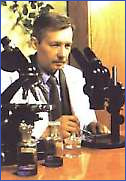Progressive threat for natural environment mainly results from an extensive number of various dusts and gases. An amount emitted pollution reaches a number of hundreds of thousand tonnes annually. Tiny portions of dust and powder constitute an essential part of the pollution. Saprophyte, fungus, bacteria develop in the dust portions causing numerous allergies. They land in all different micro-irregularities, they are inhaled together with air into our lungs not remaining indifferent for our health. Effective removing the dirt leads to limiting the threat suffering from tinea. The research results below indicate that, the traditional cleaning methods do not fully meet with our expectation. It turns out that, Raypath Cleaning Techniques, based on new fibre technologies, may successfully and with no harmful detergents remove effectively any kind of impurity.
Raypath Cleaning Technique - ECOLOGY OF TOMORROW
A correct process of applying the Raypath Cleaning Technique covers following steps:
1. Moistening the White or care Sponge with water
2. Rubbing the dirty surface in order to tear off dirt portions and change it into a state of emulsion
3. Wiping the emulsion and polishing the cleaned surface with the dump Sunbeam Sponge
4. After the cleaning process all sponges should be washed in warm water. Remaining the sponges dirty for a longer period of time may cause creating persistent dirt which can penetrate the fibres. The Sponges should be dried while hanging in room temperature
Removing dirt with a traditional method using detergents and with Raypath Cleaning Technique ECOLOGY OF TOMORROW
Research has been done on two typical surfaces found in households,
hospitals, services enterprises an industrial plants. The surfaces
imitate table tops and ceramic surfaces such as tiles, porcelain,
semi-vitreous porcelain, glass, etc. These are: beaverboard and ceramic
board. Artificial dirt is a combination of dust, carbon soot, coal
fine, silicate and grease layer.
Traditional method using detergents involves applying a cotton
rag moistened in a water mixture of detergents used for cleaning
surfaces. Three most popular detergents on Polish market from different
manufacturers had been used. And these are the results:
|
Test results for the ceramic board
|
Cleaning method
|
Moistening environment |
Average cleaning efficiency |
Cotton rag + detergents
|
Water + 1st detergent |
81 % |
| water + 2nd detergent |
86 % |
| water + 3rd detergent |
86 % |
| Raypath Technology ECOLOGY OF TOMORROW |
water
|
98 % |
|
Test results for beaverboard
|
Cleaning method
|
Moistening environment |
Average cleaning efficiency |
Cotton rag + detergents
|
water + 1st detergent |
68 % |
| water + 2nd detergent |
67 % |
| water + 3rd detergent |
75 % |
| Raypath Technology ECOLOGY OF TOMORROW |
Water |
95 % |
|
| Removing Asdpergillus Niger fungus with
a traditional method using detergents and with Raypath Cleaning
Technique ECOLOGY OF TOMORROW
Asdpergillus Niger is a fungus with the name black dropper spread
all over nature, morfibic for human
In the traditional method we a cotton rag dumped in the strongest
dilution of the detergent marked with No 3 in previous tests
|
Test results for the ceramic board
|
Cleaning method
|
Average cleaning efficiency |
detergent- after cleaning
|
99,2 % |
| RAYPATH Technique- after cleaning |
99,992 % |
|
Test results for beaverboard
|
Cleaning method
|
Average cleaning efficiency |
detergent- after cleaning
|
99,48 % |
| RAYPATH Technique- after cleaning |
99,97 % |
|
The results of carried out test indicate
that, micro-biological cleaning efficiency for surfaces infected with
bacteria and fungus is considerably higher when using Raypath Cleaning
Technique Sponge with water than in case of using cotton rag with
detergents.
|
 The tests carried out under supervision of Dr Mr Stan Pfeifer, as well as, the results indicate very high efficiency of removing the dirt with the use of Raypath Cleaning Technique in comparison with traditional methods using cotton rags and detergents. It is worth highlighting the fact of eliminating detergents harmful to natural environment while using Raypath Cleaning Technique, as well as, the fact that, the products have attests of National Hygiene Institute registered with HK/13625/96. The tests carried out under supervision of Dr Mr Stan Pfeifer, as well as, the results indicate very high efficiency of removing the dirt with the use of Raypath Cleaning Technique in comparison with traditional methods using cotton rags and detergents. It is worth highlighting the fact of eliminating detergents harmful to natural environment while using Raypath Cleaning Technique, as well as, the fact that, the products have attests of National Hygiene Institute registered with HK/13625/96.
Dr Stan Pfeifer
Merchandise Sciences Ph D.
at Industrial Merchandise Sciences Chair
An Expert
A Law Proficient in the field of fibre wares
|
|

